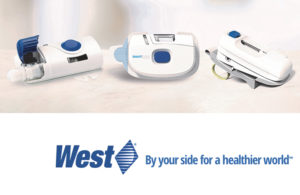Human factor testing is beneficial early on in the design process, rather than as a confirmation at the end. Here’s how testing for usability and desirability helped spark three generations of drug delivery devices.

The SmartDose Gen I device was initially used in clinical studies. From those studies, West received data from the returned devices to see what happened during drug delivery – whether it went as planned, if there were any mechanical issues or if there were any use errors. The goal was to better develop new generations of the device.
“It’s one thing to get a written report on what happened in a clinical trial, but we actually got the returned units,” Eric Resnick, VP and CTO at West Pharmaceutical Services told Medical Design & Outsourcing. “The SmartDose technology stores all the data on the circuit board. We can read the units and just see how did the program sequence through from the start of injection or not started, when the unit gets activated, when the dose was completed or when it stopped dosing and may have alarmed.”
It was the type of human factors research that has informed West through three generations of SmartDose. How the company harnessed human factors provides some important lessons for drug delivery device developers in general.
From the human factor data, West Pharmaceuticals built a database to see if certain error codes happen frequently and what could be the cause of the error code. The forensics from the device’s software show how it performs, and, along with the mechanical view, feed into making the platform better in subsequent releases.
“It could be use. It could be design,” Resnick said. “What can we do to prevent that from happening? It could be a destructive process to take something apart to see if something went wrong internally in the mechanisms. We are able to develop and deploy CT scanning to give us an image inside the device to see if something breaks or if something is out of place.”
Gen I of the SmartDose is a combination product that offers a prefilled wearable, subcutaneous injector with a drug-delivery system. The patient-centric wearable injector is a user-loaded, subcutaneous, self-administation device that delivers high-volume and high-viscosity drug products, according to the company.
“We knew we weren’t looking at a one-off product. We were trying to build a platform,” Resnick said. “When that launch got approved three years ago, we were already moving down a number of paths.”
The second generation of the SmartDose technology is similar to Gen I in that it is user loaded. The device features a separate prefilled cartridge. When ready to inject, the user inserts the cartridge into the device, which starts the process of the workflow to get ready to self-administer, Resnick said. The device also has expanded and improved software to be used with more viscous drugs, dosages up to 10 ml and faster injections. It also offers multiple programmable parameter options, can run multiple programs and handle any number of dosing regimens from minutes to hours.
“So, on the user loaded device, what we realize is it’s one thing to have people get trained on how to use devices. It’s better to eliminate the possibility of misuse or someone doing something out of order,” Resnick said. “So, what we built into it is, through our own user research, mechanical checks along the workflow.”
For example, a user won’t be able to close the door on a SmartDose device unless the cartridge is seated all the way. Users can’t initiate an injection by pressing the button until the adhesive is removed and firmly attached to the body.
“We basically just put locks in place that would prevent out-of-step or out-of-sequence activation from happening,” Resnick said. “We also just made it almost impossible for the device to be mishandled in preparation of administration.”
The Gen III SmartDose technology has some of the same benefits as Gen II in terms of improved software, electronics and power management. The difference between it and other generations is a patient would only have to open the package, remove from the blister, and the device would be ready for use. The cartridge is preloaded in the device, an idea inspired by human factor data from its previous iterations.
“That addresses partner needs where they want the patient to have to do as few steps as possible in the workflow and readying themselves for self-administration,” Resnick said. “You can see how that would be beneficial with more drugs going to less frequent dosing.”
Through each new generation of SmartDose devices, West Pharmaceutical Services takes into account usability elements of human factors — factoring in the desirability that comes out of user research. The company uses ethnographic research to look at the environment in which people are administering the drug or preparing themselves for self-administration. Observations and follow-up questions provide an understanding of how users are feeling and thinking when handling the device.
However, controlled environments are not always indicators of the real world, Resnick said. It is important to see how people are using it in the home or wherever they are self-administering as the physical environment and other activities, such as preparing dinner and talking on the phone, can affect how a patient uses the device.
“What it has taught us over the last several years is the importance of that research, using human factors as well, as a confirmation or validation of your design,” Resnick said. “We can compile design inputs from the user view that are as important as our traditional performance inputs of delivering the doses in X minutes.”
Resnick said conducting multiple human factors studies throughout the early stages of development is more important than using human factors as a confirmation at the end when arriving at the design validation. Early use of human factors can show more than feasibility — it can also show desirability and if people will use the technology according to a prescribed regimen.

